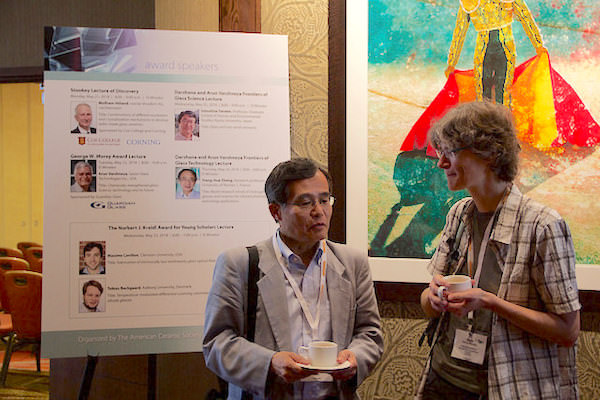
[Image above] Award lectures and networking at GOMD in San Antonio, Texas. Credit: ACerS. See images from the entire event on Flickr.
Glass. It’s a disordered material with a random structure (approximately).
But, the Glass and Optical Materials Division Meeting in San Antonio, Texas, this week has been anything but random or disordered. It couldn’t be; there was too much going on!
A record 410 people from 25 countries attended this week’s conference. France sent the most attendees—26—followed by Japan and Germany. There were 93 students here, which may be an indicator that the glass industry’s efforts to attract a workforce may be gaining some traction.
“I am really glad to see this very well attended conference provides ample opportunity for interactions among glass researchers from industry, academia, and government labs in the beautiful downtown San Antonio,” organizing chair Jingchen Du says.
GOMD held its annual business meeting, held a student poster session and awarded six prizes, and organized career roundtable and publishing workshops.
“GOMD has become a truly international and premier glass conference in the world glass community,” Du says.
GOMD starts each morning with an award lecture, and this year’s awardees were outstanding. Be sure to access the GOMD “virtual journal” from Wiley featuring articles by GOMD award winners and leading glass researchers.
The conference opened Monday with Wolfram Holand’s Stookey Lecture of Discovery. Holand reported on his nucleation and crystallization work at Ivoclar Vivadent AG on glass-ceramics for dental applications. If you have a dental crown, you care about his work!
Arun Varshneya, professor and entrepreneur, gave the George W. Morey award lecture on Tuesday. Varshneya built his dual careers on studying and producing ion-exchange strengthened glasses. His company, Saxon Glass Technologies, produces 30 million epi-pen cartridges annually, and, he cited other applications that could benefit from ion-exchange strengthened glasses, including aircraft cockpit windshields, hurricane-survivable windows, automobiles, and more pharmaceutical applications. However, he says, there is work to do to make the process more efficient.
Setsuhisa Tanabe of Kyoto University presented the Darshana and Arun Varshneya Frontiers of Glass Science lecture on Wednesday on rare earth elements in glass science. These materials are critical for photonics, which are the backbone of light-based communication.
Thursday the conference wrapped with the Darshana and Arun Varshneya Frontiers of Glass Technology lecture by Xiang-Hua Zhang from University of Rennes 1 in France. He continued the photonics theme, focusing on chalcogenide glasses for applications needing infrared-transmitting optics. For example, self-driving automobiles need lenses to see objects, such as pedestrians, in the dark.
The student Kreidl Award lecture highlights rising talent in the field, and the selection committee this year faced a dilemma. They were down to two candidates, who proved to be equally qualified. GOMD chair Pierre Lucas said, “There was just no way to decide which one was better, so the committee decided to award two of them!”
So it was that Maxime Cavillon (Clemson University advised by John Ballato) and Tobias Bechgaard (Aalborg University advised by Morten Smedskjaer) both delivered Kreidl award lectures at the end of the program on Thursday. Interestingly, both advisors were previous Kreidl award winners.
Complementing this auspicious lineup was a festschrift symposium in honor of L. David Pye, timed to coincide with the 50thanniversary of his Ph.D. graduation from Alfred University. After a brief career at Bausch and Lomb, he joined the faculty at Alfred University, eventually becoming dean. The far-reaching impact of his career was evident as former students, colleagues, and collaborators gave talks on the impact he had on their accomplishments and ability to achieve them. Kathleen Richardson, Arun Varshneya, and Edgar Zanotto—student, colleagues, and collaborators— organized the symposium.
Pye’s first graduate student, Carr Lane Quackenbush, says Pye taught him to focus on the underlying problem, not the symptoms, to separate cause from effect, and not to let daily tasks interfere with long-term objectives. Subsequent talks, in various ways, echoed the theme of Pye teaching them how to think and approach problems while unlocking the mysteries of glass.
Another Pye alum, Don McPherson, delivered the commencement address at Alfred University this spring. According to Alfred University president, Mark Zupan, McPherson told graduating students, “At Alfred, I had professors who taught me how to think, so I did.”
McPherson said in his tribute to Pye, “Dave had a unique ability to find students who were a little different and entice them to work for him.” McPherson went on to discover glasses that allow color blind people to see colors—a life-changing experience for those who suffer from it. Globally, 300–450 million people are afflicted, he says. McPherson’s company, EnChroma, now manufactures glasses, including prescription lenses, clip-on lenses, and will soon offer contact lenses.
Pye’s influence will live on long into the future in many ways, not just through people and science, but through the journal he founded, ACerS International Journal of Applied Glass Science. He served as editor since its founding in 2011 until handing over editorship to Mario Affatigato in January. Affatigato says, only half-jokingly, “My biggest fear is that he’s going to start a new glass journal!”
Pye inspired enormous respect, admiration, and affection over his 50 years teaching, mentoring, and leading. And, true to his generous nature, he brought a gift for each presenter and made a stained glass plaque for each of the three organizers.
Next year, GOMD will be part of the International Congress on Glass in Boston, Mass., which promises to be a stimulating conference for the global glass community. Mark your calendars for June 9–14, 2019. Organizers are accepting abstracts now.
See images from GOMD 2018 on Flickr.
